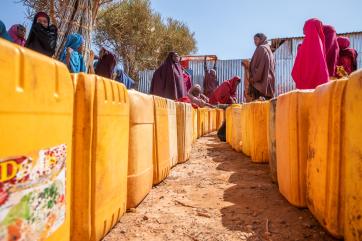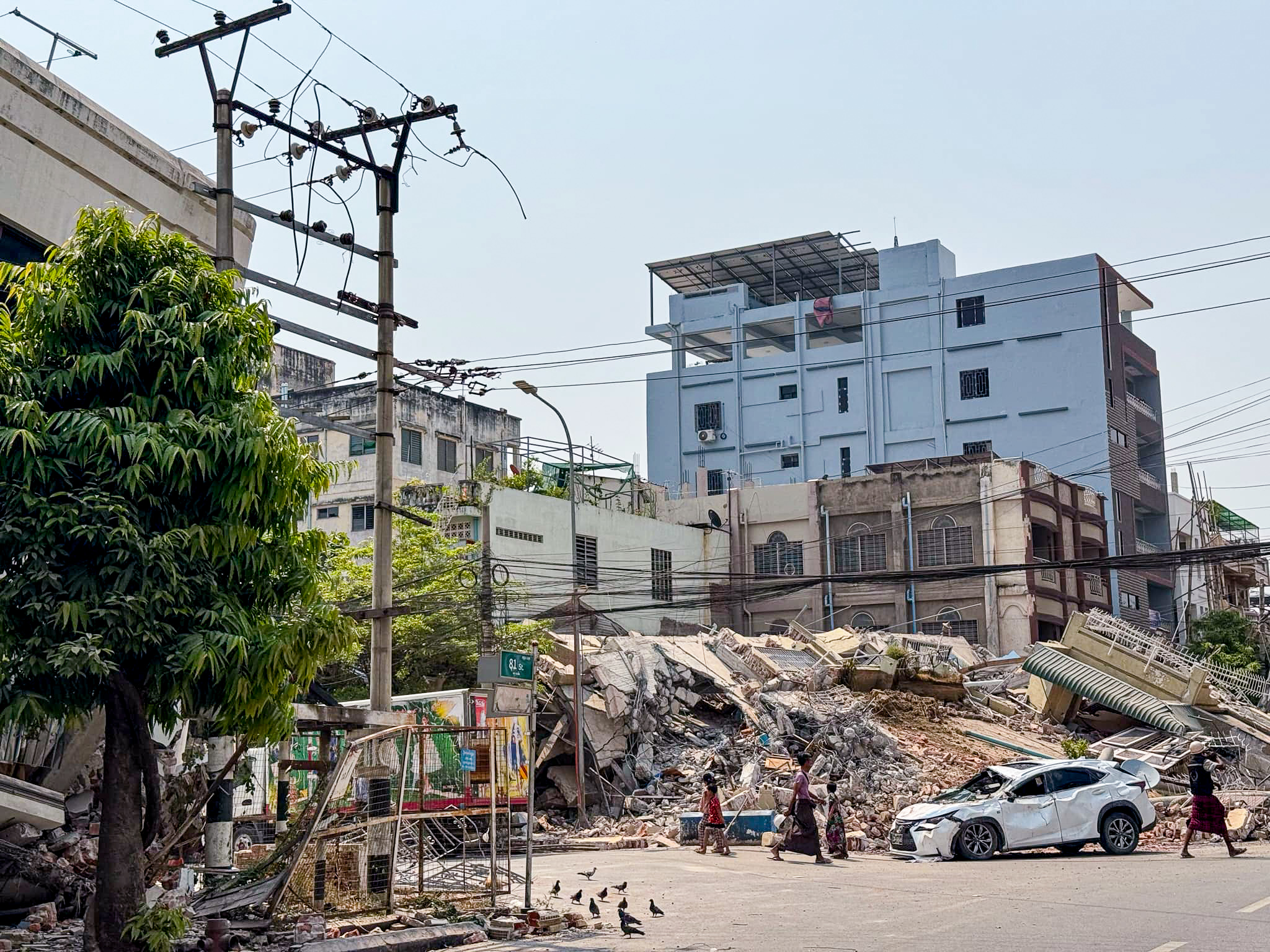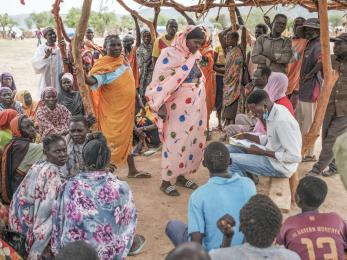A look at the drought crisis in Somalia and Kenya
“Many families have lost everything,” said Daud Jiran, Mercy Corps Country Director for Somalia, describing the devastation across the country due to this season’s severe drought. “Pastoralists have trekked hundreds of kilometers with their weakening animals looking for pasture. Most of their animals have died along the way, and the few left are feeding on cactuses and other plants, even though they can be toxic to livestock, as a last resort.”
Across the Horn of Africa, some regions are facing their driest season in 40 years. Climate change has exacerbated the frequency and severity of droughts that have now left nearly 90% of Somalia in an extreme drought following three consecutive failed rain seasons. Over 18.4 million people across Somalia, Ethiopia, and Kenya—about half of them children—are already on the verge of starvation. More than 7.5 million people have already fled their homes in search of food and water since the start of 2022. Mercy Corps is responding to immediate needs by providing cash assistance, increasing access to water, and supporting pastoralist and farmer livelihoods—with an emphasis on building resilience beyond the current crisis.
We’re sharing stories from the communities in Somalia and Kenya that Mercy Corps is supporting. From our experience working in the Horn of Africa since 2004, we understand this won’t be the last drought to strike the region. We must take urgent action to avert a deepening crisis and help communities withstand future emergencies.

In a dusty lot on the outskirts of Somalia’s capital city, Mogadishu, displaced people live in a crowded camp. After losing crops, livestock, and family members to the drought, many of the displaced have walked for weeks to arrive at the camp.
“We saw the horrific consequencesof acting too late in Somalia in 2011, when over a quarter of a million people died as a result of drought and famine,” said Daud. “In 2017 however, the Somali government and humanitarian community prevented the worst impacts of drought by swiftly acting on early warning signals, showing that a collective ‘no-regrets’ approach to funding and programming can effectively avert famine. Now, more than ever, our shared responsibility must translate into action for communities in the Horn of Africa.”

Displaced women and children gather in a shed to escape the midday heat at a camp for internally displaced people outside of Mogadishu. South of the capital city, in Lower Juba, Daud met women who brought their children in search of support and now live in makeshift shelters in camps outside of nearby towns. Their husbands stayed behind to watch over the few remaining livestock. The camps have no food, access to water, or sanitation. The women and children are “exposed while relying on the little help the local communities offer,” said Daud. “It's a scramble for survival.”


At a water tap near a camp for displaced people in Baidoa, Somalia, displaced women line up to fill their jerrycans. Mercy Corps is providing water to thousands of people displaced by the drought.
The drought crisis is further compounded by the COVID-19 pandemic, regional conflict, desert locusts, and now a surge in food prices due to the war in Ukraine. Mercy Corps is providing cash and food to the most affected families, and water in remote villages through emergency water trucking for communities and their livestock to help prevent a worsening catastrophe.

Mercy Corps’ drought response and support includes helping communities to cope with future crises in the long term. We integrate livelihoods programs while meeting emergency needs. Ikran sews a garment inside a shed outside of Mogadishu. Mercy Corps has helped her, and other women, organize a group of tailors who work together to support their displaced families.

Girls study in front of their school outside Mogadishu where displaced children transition from temporary schools into permanent ones like one pictured here. Mercy Corps is supporting the schools with water and sanitation infrastructure.
Women and girls bear the brunt of the impacts of the drought, due to prevailing gender inequality in the region. For instance, in times of crises, communities may use coping strategies like removing children from school, and girls are the first to miss out on their education. The displacement that results from drought can also lead to greater gender-based violence against women and girls. Schools not only provide education and access to water, but a sense of normalcy during a challenging time.

Pastoralist and farmer, Kheira Osman Yusuf, walks across the cracked, dry earth of the reservoir next to her farm in Adadijole, Kenya. Just a few years ago, Kheira and a group of other women were part of a vibrant and active farming group supported by Mercy Corps and is now experiencing the worst drought season she has seen since she began living in the area in 2002.
“We used to be able to grow enough tomatoes that we could stay fed for eight months,” said Kheira. “We used to have luscious mango trees and papaya trees.” Now, without rain for over a year, there are just a few neem trees left that provide some shade from the heat. Water is also a challenge. A reservoir that once provided water for people and livestock has almost completely dried up. Mercy Corps is working with the community to build an irrigation system here, but without rain, the project is unable to be completed. Kheira is hopeful that when the rain comes, the irrigation system will be built and they’ll be able to grow food again.

Leparin Lolmongi pulls water from deep in the earth at a migration water point in East Samburu, Kenya, where dozens of other pastoralists have trekked for days—some from over 200 kilometers away—to reach a water source. His camels drink from a trough behind him. Leparin fills up bucket after bucket, knowing that he will need to store enough water for both himself and his animals for their onward journey. As a migratory pastoralist, Leparin’s camels are his livelihood. Due to the drought, and increasingly limited food supply, intercultural conflicts are also a risk factor in the area, making life more challenging for all.


A thriving water source once provided more than enough water for this Samburu woman and her community near the Lesepe Dam in Baragoi, Kenya. Now the women gather to pray for rain, after a year without it. Every day, she and other women—mothers and grandmothers—walk two kilometers from their village in scorching heat to the dam for this special ceremony. She pours a bit of water on weeds, symbolizing the women’s request for rainfall.
The women pray, sing, and splash milk in the air during the ritual. When the ceremony is completed, the women take refuge underneath canopying trees for shade, drinking sips of water to replenish themselves before making the journey back to their village. They will return to the dam on the next day, to pray again for rain.

Elizabeth Akaale holds her daughter, who is currently ill with malaria and diarrhea. Elizabeth is a mother to seven children, living in Turkana, Kenya, which has been experiencing severe drought for months. “Because of the drought, we are skipping meals. I have to ration supper, and divide meals so that some of my children who need additional food are able to eat more than others,” said Elizabeth.
Just a few months ago, her daughter was severely malnourished and received critical health care from this nearby clinic, which is supported in part by Mercy Corps. Her daughter receives regular health exams, malaria medication, and supplementary food during their visits.

Abdia Muktar Omar is a mother to three children in a small village in Northern Wajir, Kenya. With a cash grant from Mercy Corps, she opened a shop where she sells food and household items. As a participant in a Mercy Corps program promoting livelihoods for women, she also learned basic financial planning, bookkeeping, and business skills to help supplement lost income from drought-affected businesses. Livestock farming has diminished due to the drought, which means fewer customers for Abida. “If it doesn’t rain, the shop won’t survive,” said Abida.
The hope for rainfall is shared across the region as communities struggle with compounded crises. In order to meet urgent needs caused by the drought, Mercy Corps is increasing access to water, distributing cash assistance, and providing animal feed and veterinary care to pastoralists. Our teams are collaborating with local health authorities and governments to expand services. Time is of the essence to prevent the most devastating potential impacts on lives and livelihoods.


